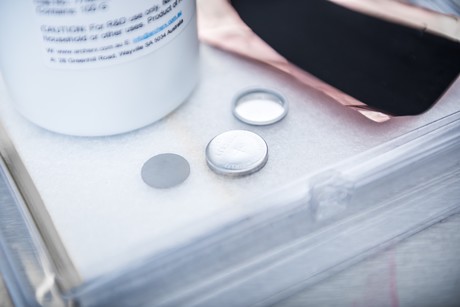South Australian graphite deployed in full-cell Li-ion batteries

Resources company Archer Exploration has collaborated with UNSW on the development of full-cell lithium-ion batteries, made with graphite mined from Campoona, South Australia.
Lithium-ion batteries are commonly referred to by the constituents in the cathode, as the chemistry of the cathode can often limit performance — prominent technologies for automotive applications include lithium-nickel-manganese-cobalt (NMC), lithium-nickel-cobalt-aluminium (NCA) and lithium-iron phosphate (LFP) chemistries, while lithium-cobalt oxide (LCO) is predominantly used in consumer electronics. Improvements in the anode are meanwhile centred on using graphite with high structural quality and purity, plus an appropriate particle size and optimal morphology for effective lithium-ion intercalation chemistry.
The new batteries were constructed using NMC, LFP and LCO in the cathode and Archer’s Campoona graphite at the anode. The NMC and LCO cathode chemistries were prepared at UNSW, while the LFP cathode materials used were commercially sourced. All synthesis, fabrication, characterisation and testing was carried out at UNSW. Functional, commercially scalable batteries were successfully assembled as coin cells and validated for performance.

Archer’s 99% acid-leached Campoona graphite was used with no further optimisation. Key battery performance parameters, including specific capacity and cycle stability, were in line with industry state-of-the-art values, owing in part to the graphite’s impressive structural and chemical properties.
“Collaboration with UNSW has greatly accelerated our advance in the battery space,” said Archer CEO Dr Mohammad Choucair. “We are now able to demonstrate complete, functioning and commercially relevant batteries with Archer’s graphite. We have reached a major milestone towards integrating our substantial graphite resource in the lithium-ion battery supply chain.
“It is important that we formulated, built and tested full-cell batteries using Campoona graphite using different cathode chemistries, as there is no one industry standard cathode for lithium-ion batteries, with different manufacturers using different chemistries. The work definitively shows that Archer’s graphite can be used in conjunction with different types of cathodes, making it suitable for multiple potential battery markets.”
Archer’s focus will now be on addressing the trade-off between cost and battery performance. The company will also continue to target partnerships with lithium-ion battery manufacturers to scale and integrate Campoona graphite further downstream in the supply chain. Knowledge sharing with potential commercial partners will be facilitated in confidence through the availability of technical data detailing the outcomes of this work.
The collaboration with UNSW will meanwhile continue, with the aim of co-developing intellectual property associated with reaching ultrahigh graphite purities and establishing optimal morphologies for lithium-ion intercalation chemistry useful for commercially relevant cathode formulations.
With the global lithium-ion battery market forecast to grow over the next 10 years to US$130 billion, the outcomes of the work will be used by Archer to target potential offtake partners in the battery supply chain and electric vehicle markets.
Berrima Cement Works upgrades with sustainable tech
Boral has unveiled new carbon-reducing technology at the site, which supplies 40% of cement in...
Australian orgs partner to speed circular economy
GS1 Australia has joined forces with the Product Stewardship Centre of Excellence to drive the...
Victorian utility recognised at Asian Water Awards
South East Water won two awards for its Hydrotrak Geofencing technology, which has helped it to...









